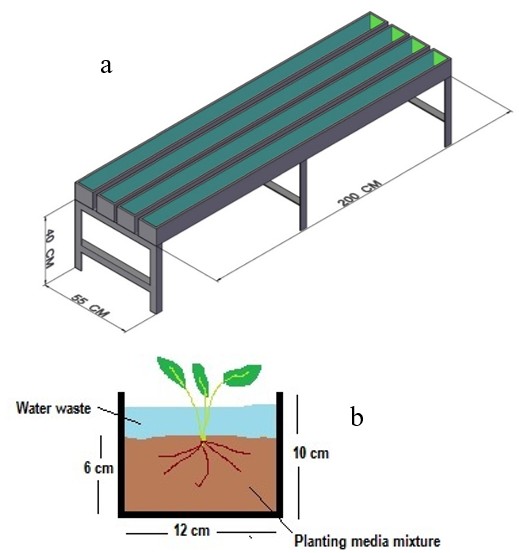Domestic Wastewater Influent Treatment in Reservoir B of Lampung University Using Constructed Wetlands (CWs)
DOI:
https://doi.org/10.51264/inajl.v6i1.70Keywords:
Constructed wetlands (CWs), Domestic wastewater, Grey water, ReservoirAbstract
This study aims to analyze the effectiveness of the Constructed Wetlands (CWs) method in improving the quality of domestic wastewater before it enters Resevoir (Embung) B at Universitas Lampung. Embung B, which has the largest storage capacity on campus, also receives domestic wastewater (grey water) from residential areas and a terminal. The CWs method was applied using bamboo water (Equisetum hyemale) and water jasmine (Echinodorus palaefolius), with and without the addition of moss. Water quality parameters such as pH, TSS, BOD, COD, NH?-N, TDS, EC, temperature, and DO were tested. The results show that the combination of bamboo water with moss (P3) and water jasmine with moss (P4) was the most effective in reducing pollutant concentrations, with several parameters such as TSS, pH, and NH?-N meeting the domestic wastewater quality standards in accordance with Government Regulation No. 22 of 2021. Although BOD and COD did not fully meet the standards, there was a significant reduction compared to initial conditions. These findings suggest that the CWs system has potential as an eco-friendly and cost-effective technology for domestic wastewater treatment, especially in small-scale environments such as campuses or residential areas.
References
Ba?kor, M., Goga, M., Singh, P., & Tuptová, V. (2023). Mechanisms of copper toxicity and tolerance in the aquatic moss taxiphyllum barbieri. Plants, 12(20), 1–14. https://doi.org/10.3390/plants12203607
Elhassan, E. E. M., Sláde?ek, M., Badaam, S., Brynychová, K., Chajma, P., Firlová, V., … Šálek, M. (2021). An Artificial Lakes System Intended for Human Recreation Supports a Vital Breeding Population of Red-wattled Lapwing in the Arabian Desert. Avian Conservation and Ecology, 16(2), 20. https://doi.org/10.5751/ACE-01978-160220
Fajar, I., Yudha Perwira, I., & Made Ernawati, N. (2022). Pengaruh derajat keasaman (pH) terhadap pertumbuhan bakteri toleran kromium heksavalen dari sedimen mangrove di Muara Tukad Mati, Bali. Current Trends in Aquatic Science, 5(1), 1–6.
Ginghin?, R. E., Bojin, D., Miculescu, F., Zamora Iordache, P., ?ig?nescu, T. V., & Antoniac, I. (2020). The ph influence in the process of industrial wastewater treatment. UPB Scientific Bulletin, Series B: Chemistry and Materials Science, 82(4), 355–365.
Government Regulation .(2021). Peraturan Pemerintah republik Indonesia Nomor 22 Tahun 2021 Tentang Penyelenggaraan Perlindungan dan Pengelolaan Lingkungan Hidup (No. PP No.22). Indonesia. Retrieved from https://peraturan.bpk.go.id/Details/161852/pp-no-22-tahun-2021
Hassan, I., Chowdhury, S. R., Prihartato, P. K., & Razzak, S. A. (2021). Wastewater Treatment Using Constructed Wetland: Current Trends and Future Potential. Processes, 9(11), 1–27. https://doi.org/10.3390/pr9111917
Li, X., Yang, L., Xu, K., Bei, K., Zheng, X., Lu, S., … Jin, Z. (2021). Application of constructed wetlands in treating rural sewage from source separation with high?infuent nitrogen load: a review. World Journal of Microbiology and Biotechnology, 37, 138. https://doi.org/10.1007/s11274-021-03105-3
Liu, W., Junfeng, W., & Liu, T. (2019). Low pH rather than high CO2 concentration itself inhibits growth of Arthrospira. Science of The Total Environment, 666, 572–580. https://doi.org/https://doi.org/10.1016/j.scitotenv.2019.02.312
Nadhifah, I. I., Fajarwati, P., & Sulistiyowati, E. (2019). Fitoremediasi dengan wetland system menggunakan eceng gondok (Eichhornia crassipes), genjer (Limnocharis flava), dan Semanggi (Marsilea crenata) untuk mengolah air limbah domestik. Al-Kauniyah: Jurnal Biologi, 12(1), 38–45. https://doi.org/10.15408/kauniyah.v12i1.7792
PUPR. (2021). Bangun Hunian Nyaman Bagi Mahasiswa, Kementerian PUPR Targetkan Rusun Kampus Unila Selesai Akhir 2021. Retrieved February 7, 2023, from https://pu.go.id/kanal-gallery/630
Qing, D., Richard, M., & Keat, S. (2015). Application of constructed wetlands for wastewater treatment in tropical and subtropical regions ( 2000 – 2013 ) ScienceDirect. Journal of Environmental Sciences, 30, 30–46. https://doi.org/10.1016/j.jes.2014.10.013
Ramadani, R., Samsunar, S., & Utami, M. (2021). Analisis Suhu, Derajat Keasaman (pH), Chemical Oxygen Demand (COD), dan Biologycal Oxygen Demand (BOD) dalam Air Limbah Domestik di Dinas Lingkungan Hidup Sukoharjo. IJCR-Indonesian Journal of Chemical Research, 6(2), 12–22. https://doi.org/10.20885/ijcr.vol6.iss1.art2
Sari, M. O. S. K., Hasuti, E. D., & Darmanti, S. (2019). Potential of Water Jasmine (Echinodorus palaefolius) In Phytoremediation of Fe in Leachate Jatibarang Landfill. Journal of Biology & Biology Education (Biosaintifika), 11(1), 55–61. https://doi.org/10.15294/biosaintifika.v11i1.17447
South, A. E., & Nazir, E. (2016). Karakteristik air limbah rumah tangga (grey water) pada salah satu perumahan menengah keatas yang berada di Tanggerang Selatan. Ecolab, 10(2), 80–88.
Sun, Y., Xu, S. G., Kang, P. P., Fu, Y. Z., & Wang, T. X. (2019). Impacts of Artificial Underground Reservoir on Groundwater Environment in the Reservoir and Downstream Area. International Journal of Environmental Research and Public Health, 16(11), 1921. https://doi.org/10.3390/ijerph16111921
Suswati, A. C. S. P., & Wibisono, G. (2013). Pengolahan limbah domestik dengan teknologi taman tanaman air (Constructed Wetlands). Indonesian Green Technology Journal, 2(2), 70–77.
Sutriati, A., & Ginting, T. (2012). Potensi air limbah domestik sebagai pasokan air irigasi pada daerah padat penduduk dan krisis air. Jurnal Irigasi, 7(2), 87–98.
Sutyasmi, S., & Susanto, H. B. (2013). Penggunaan tanaman air (bambu air dan melati air) pada pengolahan air limbah penyamakan kulit untuk menurunkan beban pencemar dengan sistem wetland dan adsorpsi. Majalah Kulit, Karet, dan Plastik, 29(2), 69–76.
Van Der Wal, R., Pearce, I. S. K., & Brooker, R. W. (2005). Mosses and the struggle for light in a nitrogen-polluted world. Oecologia, 142, 159–168. https://doi.org/10.1007/s00442-004-1706-0
Vymazal, J. (2010). Constructed wetlands for wastewater treatment. Water, 2(3), 530–549. https://doi.org/10.3390/w2030530
Zhao, X., Chen, J., Guo, M., Li, C., Hou, N., & Bai, S. (2022). Constructed wetlands treating synthetic wastewater in response to day-night alterations: Performance and mechanisms. Chemical Engineering Journal, 446(5). https://doi.org/https://doi.org/10.1016/j.cej.2022.137460
Zhou, Z., Jing, S., Gong, Y., & Zhao, H. (2021). Classification and Identification of Artificial Lakes Based on National Geographic-Conditions Data. ISPRS Annals of the Photogrammetry, Remote Sensing and Spatial Information Sciences, 5(4), 187–192. https://doi.org/10.5194/isprs-annals-V-4-2021-187-2021

Downloads
Published
Issue
Section
License
Copyright (c) 2025 Elhamida Rezkia Amien, Puspita Yuliandari, Muhammad Haviz

This work is licensed under a Creative Commons Attribution 4.0 International License.






